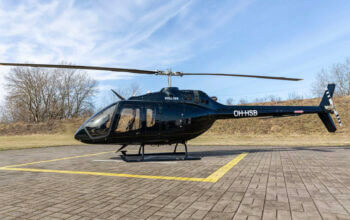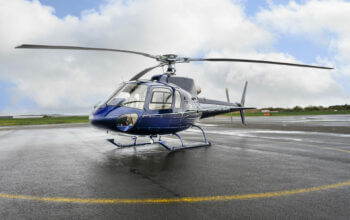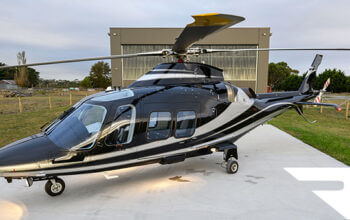Estimated reading time 9 minutes, 26 seconds.
An aircraft is a technological wonder and a thing of beauty – the sum of thousands of parts all working in harmony to achieve flight. And, while countless parts go into the making of a new helicopter or fixed-wing aircraft, perhaps none is as unobtrusive, yet as essential, as the humble shim.
Shims are simply thin pieces of metal, wood or other material – often but not always tapered – that are used to fill small gaps between parts or objects. Carpenters use wooden-wedge shims to level surfaces or fill gaps between materials. And, maybe somewhat surprisingly, aircraft manufacturers have critical uses for shims, too.
Shimco North America is a Canadian company that specializes in the production of shims for aerospace, defense and industrial use. Established in 1985 in Markham, Ont., it is the only company of its kind in Canada and one of very few aerospace shim manufacturers in the world. Over the last 20 years or so, Shimco’s product offerings have evolved to focus largely on aerospace applications. Today, it manufactures several different types of customized shims: solid, laminated, edgebonded and tapered.
Shimco’s president, Peter Voss, said that about 85 per cent of the company’s business is rooted in the aerospace/defence niche, while the remaining 15 per cent is based on industrial products. Its biggest contracts are with Bell Helicopter and Bombardier Aerospace, but Shimco also does work for other well-known aviation OEMs (original equipment manufacturers) worldwide, including Embraer, Honda Aircraft Co., and Mitsubishi Aircraft Corp.
“Shims have various uses in aviation,” Voss told Canadian Skies. Tapered shims, for example, are designed to deal with angles and curves; they ensure a close-tolerance fit whenever relatively large spaces occur between adjacent parts. These shims are inserted as far as they can go and then the excess is removed.
“The more advanced shims are the laminated and edgebonded products,” he continued. “We machine them from aerospace-grade aluminum, titanium, stainless steel, brass or Kapton [a polyimide film developed by DuPont] that we laminate on site. Edgebonded shims are used in helicopter engine and transmission assemblies, for example, to eliminate the tiny spaces between parts that result from allowable manufacturing tolerances. The manufacturer actually takes off the layers they need, as opposed to removing what they don’t need, as in a laminated shim. You peel off the thickness you need to get the perfect fit.”
Voss has over 20 years of manufacturing experience, a good portion of which was in aerospace. But he has learned a lot about shims over the past year and a half. He and his business partner, James Cunningham, purchased Shimco from its original owners in early 2011; and at the time, they knew little about the company’s products. Voss retained key upper management personnel, invested heavily in company infrastructure, upgraded the IT system and hired a quality manager to implement lean manufacturing concepts. Cunningham, who lives in the UK, operates from behind the scenes and supports Shimco’s marketing efforts to clients across the globe.
“We’re working hard to keep up with our production demand. Our output is 20 per cent higher than last year, and it’s expected to be another 25 per cent higher next year,” said Voss, adding that the company currently produces about 600,000 parts a year. “Business is really booming. We’ve now added a second shift, so our production floor is running from 7 a.m. through to 1:30 a.m.”
The efforts of Voss and his 30 employees have not gone unnoticed. Recently, Shimco received Bell Helicopter’s coveted “Premier Supplier” designation for the first time. To receive the designation, a supplier must meet a number of stringent quality and delivery standards, and achieve a high score during an onsite inspection.
“Bell came in August 2011,” said Voss. “They looked at IT systems, quality systems, health and safety systems, information reporting, financial results. . . they went through everything. You had to have a four or five [out of five] in every category to make it.”
Earning the Bell designation was definitely a feather in Shimco’s cap, said Voss, but the company is aiming even higher. Future expansion plans include “moving up the food chain” by producing component kits for sub-assemblies, and signing new contracts with other major aircraft manufacturers.
“We’re aiming to penetrate the commercial aerospace market. We do some work for Boeing and Airbus, in a small way, through other customers; but, we want to get in directly with them,” said Voss. “Right now, we’re mainly in the regional jet and helicopter markets, but getting involved directly with commercial OEMs would help us with our business forecasting and increase our exposure.”
Shimco is also focusing on international markets. The company currently does some work in Europe, and supplies Brazil’s Embraer with most of its shim stock in sheet form. But the company has the capacity to handle more business, so Voss teamed up with the Canadian Trade Commissioner Service to get help assessing and preparing for international markets, and finding qualified business contacts.
“The Trade Commission provides a lot of valuable contacts and cultural insight,” he commented. “Japan and Brazil, for instance, are very big on personal relationships. So I’ll be
going there every six months at least. That personal relationship building is extremely important, even more so than in North America.”
Along the same lines, Voss and his crew attend numerous industry trade shows. At Heli-Expo 2012, a representative from a large company approached them to say they were unhappy with their current shim provider, opening the door to a new business relationship. “On-time delivery and quality is a given in the aerospace industry,” said Voss, “but this business is really about the relationships. Customers need to believe that they can count on you to perform and not be an issue for them.”
Shimco is also working with the National Research Council to introduce advanced technologies to the company, and is hoping to get funding for two or three projects. In keeping with its culture of innovation, the shim manufacturer has also ordered a new high tech lathe that takes “a hardened hockey puck” of raw material and turns it into a specialized, extremely tight tolerance part in a mere seven minutes. In addition, Shimco has started to work with companies in Europe and Japan which supply carbon fibres to the aerospace industry. The goal is to produce shims and other parts that will be compatible with composite aircraft.
At some point, said Voss, plans also call for the company to assume full control of the parts production process. “Potentially, we’d be looking at a processing line for chemical treatment and painting so that we have everything under one roof.”
That arrangement would help the company to meet increasing demand, including that which results from its renewed long-term supply agreement with Bombardier Aerospace. According to Voss, aircraft manufacturers are moving to pare down their approved supplier lists, choosing to deal with only selected companies in an effort to streamline parts procurement and ensure top quality.
As markets tighten and OEMs shrink their list of approved suppliers, Voss and his staff are determined to find the perfect fit for Shimco in an increasingly competitive market.











